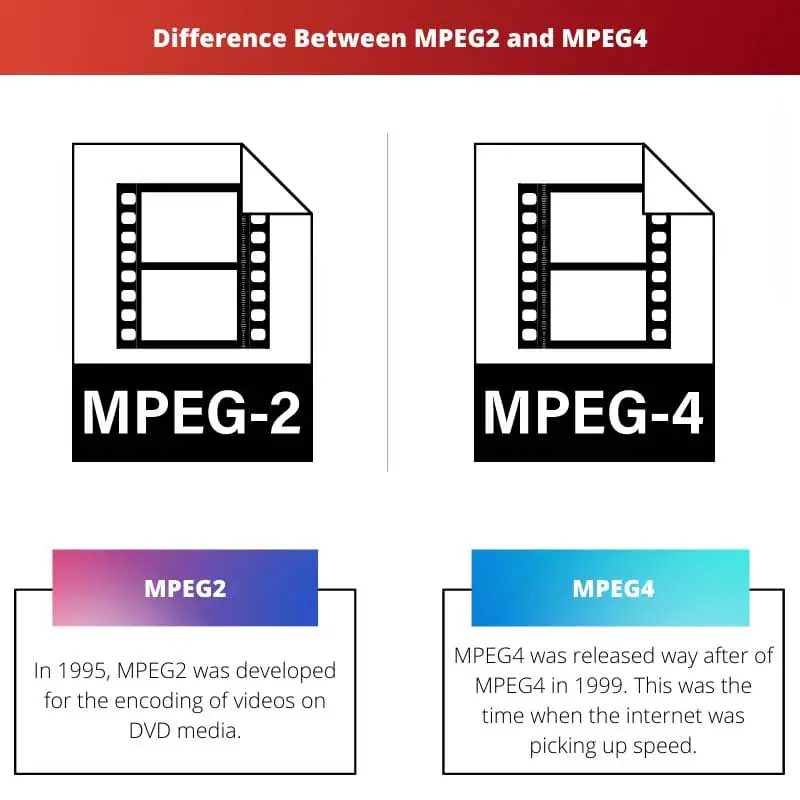MPEG stands for Moving Pictures Experts Group. This is a body that develops standards for video encoding. The two major standards are MPEG2 and MPEG4.
Key Takeaways
- MPEG2 is an older, less efficient compression standard mainly used for DVDs and broadcast television.
- MPEG4 is a newer, more advanced compression standard that supports a wider range of applications, including internet streaming and mobile devices.
- MPEG4 offers better video quality at lower bitrates, making it more suitable for high-quality video streaming.
MPEG2 vs MPEG4
MPEG2 is the standard coding for moving pictures and their audio information, and it combines lossy audio and video data compression methods to store movies. MPEG4 stands for Moving Pictures Expert Group 4 and is the audio and video coding compression method that reduces the file size while retaining the quality.

MPEG2 was developed to facilitate the encoding of videos on DVDs. DVD media was an emerging platform when MPEG2 was developed. Later, online streaming came into play. MPEG2 was not compatible with streaming videos from the internet, and thus, MPEG4 was developed.
MPEG4 overcame the limitations of MPEG2. It could easily stream online videos even though both MPEG2 and MPEG4 could maintain the video quality.
MPEG4 was helpful for portable devices like mobile phones and media players, unlike MPEG2. This also is a preferred format as it provides video files of smaller sizes.
Comparison Table
| Parameter of Comparison | MPEG2 | MPEG4 |
|---|---|---|
| Encoding | For the encoding of DVDs, MPEG2 is used. | For the encoding of portable devices and internet streaming, MPEG4 is used. |
| Size | The size of MPEG2 videos is more significant in comparison to MPEG4. | The size of MPEG4 videos is smaller in comparison to MPEG2. |
| Bandwidth Requirement | MPEG2 requires a broader bandwidth in comparison to MPEG4. | MPEG4 requires a smaller bandwidth in comparison to MPEG2. |
| Quality | Video files of MPEG2 are of higher quality. | Video files of MPEG4 are not as suitable as video files of MPEG2. |
| Extensions | Examples of extensions of MPEG2 are .mp2, mp3, .mpeg, etc. | Examples of extensions of MPEG4 are: .m4a, .m4b, .m4r, .mp4, etc. |
What is MPEG2?
In 1995, MPEG2 was developed to encode videos on DVD media.
It uses a block-based eight-by-eight DCT to compress video coding in its algorithm.
In 1995, the DVD platform was booming, so MPEG2 was ideal for video encoding.
The advantage of MPEG2 is that it maintains high-quality video files.
The disadvantage of MPEG2 is its inability to shrink the file size.
MPEG2 files are used for DVD storage, resulting in larger file sizes.
Usually, MPEG2 video files are more massive. These are ideal for DVDs and TV broadcasts.
This is why it is a preferred format for over-the-air Televisions like Dish Network, etc.
MPEG2 is better than MPEG4 in terms of quality.
It has a bitrate range of 5 to 8 Mbits/sec and requires a broader bandwidth than MPEG4 files. The bandwidth of MPEG2 is up to 40 MB/second. It used the encoding of H.262.
Video files encoded using MPEG2 have the following extensions: .mpeg, .m2v, .mp2, mp3, .mpg.
MPEG2 uses a simple algorithm to compress files and provides superior image quality.
For the compression of videos, MPEG2 discards the information in portions so that the image frame does not change.
Then it only saves the portion where any new information is included. Thus, it has a straightforward algorithm in comparison to MPEG4. MPEG2 is also used for Blu-ray Discs.

What is MPEG4?
MPEG4 was released way after MPEG4 in 1999. This was the time when the internet was picking up speed. Online videos were emerging, and the streaming of videos through the internet became popular.
MPEG2 was not compatible with portable devices, and thus, a need for a better standard came up.
MPEG4 overcame the limitation of MPEG2.
It was a format that was compatible with portable devices like mobile phones. It was also suitable for media players. This is because of its sophisticated algorithm, unlike MPEG2.
This also allows it to be a more versatile format than MPEG2.
MPEG4 provides the additional advantage of compressing the file to reduce the file size. This is essential for the transfer and streaming of videos through the internet.
It utilizes the encoding of H.264.
MPEG4 lacks in one area, which is the quality of videos.
Since it compresses file size to facilitate a smooth transfer of video files over the internet, it also reduces the quality of the files.
It also requires lower bandwidth and bit rate in comparison to MPEG2. Its bit rate requirement ranges in Kilobytes per second, unlike MPEG2.
Its bandwidth requirement is also around 64 kbps, which is very low compared to the bandwidth requirement of MPEG2 files, which is around 40 Mbps.
Thus, MPEG4 emerged as a universal format for video files because of its small size and low transmission requirements.

Main Differences Between MPEG2 and MPEG4
- MPEG2 video files are suitable for DVD media and television broadcasts. In contrast, MPEG4 files are compatible with portable devices like phones and media players.
- MPEG2 provides better video quality as compared to MPEG4.
- MPEG2 has a bandwidth requirement of about 40 Mbps, whereas MPEG4 has a bandwidth requirement of about 64 Kbps.
- MPEG4 is more suitable for the transmission of videos via the internet as compared to MPEG2.
- Examples of MPEG2 file extensions are mp2, mp3, .mpeg, etc. Whereas, example of MPEG4 file extensions are .m4a, .m4b, .m4r, .mp4, etc.

- https://www.spiedigitallibrary.org/conference-proceedings-of-spie/4310/0000/Motion-vector-synthesis-algorithm-for-MPEG-2-to-MPEG-4/10.1117/12.411870.short
- https://ieeexplore.ieee.org/abstract/document/1678121/

This article provides comprehensive information about the differences between MPEG2 and MPEG4, as well as their application and advantages. It is highly informative and well-researched.
This article effectively outlines the advantages and disadvantages of MPEG2 and MPEG4, offering nuanced insights into the trade-offs between video quality and file size. Impressive work.
The article does a great job of highlighting the historical context and development of MPEG2 and MPEG4, shedding light on how technological advancements and emerging platforms influenced these standards.
The historical context of MPEG2’s development for DVDs and the subsequent rise of MPEG4 in the internet era is eloquently presented in this article, offering a rich narrative of technological progression.
The comparison table provides a clear overview of the key differences between MPEG2 and MPEG4, making it easier to understand the technical specifications and performance of these standards.
The in-depth analysis of MPEG2’s algorithm and MPEG4’s sophisticated encoding method provides valuable insights into the technical underpinnings of these compression standards. Well-researched and articulate.
The discussion on bandwidth requirements and file size comparisons between MPEG2 and MPEG4 contributes to a holistic understanding of their performance and suitability for different media platforms. Excellent elucidation of technical concepts.
While MPEG2 excels in video quality, the emergence of MPEG4 as a versatile format for portable devices and internet streaming is well-captured in this article. A valuable resource for understanding digital video standards.
The explanations of MPEG2 and MPEG4 are detailed and thorough, offering a robust analysis of their functionalities and compatibility with different platforms. Great read!
MPEG2 and MPEG4 are two significant compression standards, and this article effectively captures their respective strengths and applications. Well-written and insightful.